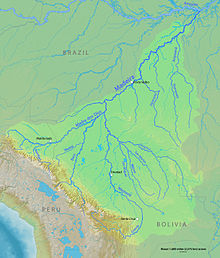Proto-Tupian language
| Proto-Tupian | |
|---|---|
| PT | |
| Reconstruction of | Tupian languages |
| Region | Madeira River basin? |
| Era | ca. 3000 BCE |
| Lower-order reconstructions | |
Proto-Tupian (PT) is the reconstructed common ancestor of all the Tupian languages. It consists, therefore, of a hypothetical language, reconstructed by the comparative method from data of the descendant languages.
In Brazil, Tupian historical-comparative studies are being developed mainly by two scientific teams: one from the Laboratório de Línguas Indígenas (LALI) of the University of Brasília, under the coordination of Aryon Rodrigues; and the other one from the Museu Paraense Emílio Goeldi, located in Belém, under the orientation of Denny Moore. These studies provide evidence about the Proto-Tupian economy and culture, suggesting, for example, that they had agriculture.[1]
The most accepted theory is that the Tupian language family originated between the Guaporé and Aripuanã rivers, in the Madeira River basin. There are currently 70 Tupian languages, including Tupi, Paraguayan Guarani, Awetï, Ayvu, etc.
Linguistic homeland
[edit]
Rodrigues (2007) considers the Proto-Tupian linguistic homeland to be somewhere between the Guaporé and Aripuanã rivers, in the Madeira River basin. Much of this area corresponds to the modern-day state of Rondônia, Brazil. Five of the ten Tupian branches are found in this area, as well as some Tupi–Guarani languages (especially Kagwahiva), making it the probable linguistic homeland of these languages and maybe of the peoples that traditionally speak them. Rodrigues believes that Proto-Tupian dates back to around 5000 BP.
O'Hagan (2014)[2] proposes that Proto-Tupi-Guarani was spoken in the region of the lower Tocantins and Xingu Rivers. Proto-Omagua-Kokama then expanded up the Amazon River, Proto-Tupinamba expanded south along the Atlantic coast, and the Southern branch expanded up along the Tocantins/Araguaia River towards the Paraná River basin.
Lexicon
[edit]This section lists Proto-Tupían reconstructions from Rodrigues and Cabral (2012). Since the reconstructions are highly tentative, the Proto-Tupían forms are all marked by two asterisks.[3]
For a list of Proto-Tupian reconstructions by Nikulin (2020),[4] see the corresponding Portuguese article.
Independent nouns
[edit]Proto-Tupian independent nouns:[3]: 511
|
|
Dependent nouns
[edit]Proto-Tupian dependent nouns:[3]: 511
|
|
Verbs, affixes, and others
[edit]Proto-Tupian verbs, affixes, and other parts of speech:[3]: 527
|
|
Cultural vocabulary
[edit]Proto-Tupían cultural vocabulary (Rodrigues and Cabral 2012):[3]: 562–563
Proto-Tupian Gloss **up 'father' **čɨ 'mother' **čɨʔɨt 'mother's sister' **amõj 'grandfather' **aʔɨt 'man's son' **memɨt 'woman's child' **men 'husband' **atʔɨ 'wife' **ike 'man's older brother' **kɨpʔɨʔɨt 'man's younger brother' **kɨpwɨt 'woman's brother' **wamu(ã) 'shaman' **ekw 'house' **ekwen 'door' **tʔap 'thatch' **upap 'lying place' **eɾĩ 'hammock' **acoʔi 'to cover' **ekwat 'village patio' **ŋo ~ ŋe 'cultivated field' **čɨt 'digging stick' **mani 'manioc' **awa(i) 'yams (Dioscorea sp.)' **wetjɨk 'sweet potato' **kuɾua 'pumpkin' **pe 'tobacco' **ɾjuku 'achiote (Bixa orellana)' **ɨʔa 'calabash' **ekwʔɨp 'arrow' **wekeʔa 'fish trap' **wɨ 'ax' **ɨɾju 'basket' **čʔam 'rope' **waʔẽ 'ceramic pot' **čɨt 'to bake' **wɨp 'to bake, to cook' **mõj 'to cook' **eʔe 'to grate' **čekw 'to pound'
See also
[edit]- Apapocuva
- Indigenous languages of the Americas
- Languages of Brazil
- Lingua Geral
- List of Spanish words of Indigenous American Indian origin
References
[edit]- ^ Rodrigues, Aryon dall'Agna & Ana Suelly Arruda Câmara Cabral. Investigando a origem e o desenvolvimento de orações dependentes nas famílias do tronco lingüístico Tupi Archived 2016-03-03 at the Wayback Machine. Revista da Abralin, volume 5, numbers 1 and 2 (ten/2006)
- ^ O'Hagan, Zachary (with Keith Bartolomei, Natalia Chousou-Polydouri, Emily Clem, Erin Donnelly and Lev Michael). 2014. A Computational-phylogenetic Classification of Tupí-Guaraní and its Geographical Spread. Language Variation and Change, October 20, Chicago.
- ^ a b c d e Rodrigues, Aryon Dall'Igna; Cabral, Ana Suelly Arruda Câmara (2012). "Tupían". In Grondona, Verónica; Campbell, Lyle (eds.). The Indigenous Languages of South America. The World of Linguistics. Vol. 2. Berlin: De Gruyter Mouton. pp. 495–574. ISBN 9783110255133.
- ^ Nikulin, Andrey. 2020. Proto-Macro-Jê: um estudo reconstrutivo. Doctoral dissertation, University of Brasília.
Further reading
[edit]- Lyle Campbell (21 September 2000). American Indian Languages: The Historical Linguistics of Native America. Oxford University Press. pp. 199, 201. ISBN 978-0-19-534983-2.
- Spike Gildea (1998). On Reconstructing Grammar: Comparative Cariban Morphosyntax. Oxford University Press. pp. 5, 53, 86, 88. ISBN 978-0-19-510952-8.
- Rik van Gijn; Jeremy Hammond (15 October 2016). Switch Reference 2.0. John Benjamins Publishing Company. pp. 15–16. ISBN 978-90-272-6677-4.
((cite book)):|work=ignored (help) - Rodrigues, Aryon Dall'Igna (2007). "As consoantes do Proto-Tupí". In Ana Suelly Arruda Câmara Cabral, Aryon Dall'Igna Rodrigues (eds). Linguas e culturas Tupi, p. 167-203. Campinas: Curt Nimuendaju; Brasília: LALI.
| Arikem | |||||||||||||||||||||
|---|---|---|---|---|---|---|---|---|---|---|---|---|---|---|---|---|---|---|---|---|---|
| Tupari | |||||||||||||||||||||
| Mondé | |||||||||||||||||||||
| Puruborá– Ramarama | |||||||||||||||||||||
| Yuruna | |||||||||||||||||||||
| Munduruku | |||||||||||||||||||||
| Maweti–Guarani |
| ||||||||||||||||||||
| Proto-languages | |||||||||||||||||||||
Italics indicate extinct languages | |||||||||||||||||||||
Text is available under the CC BY-SA 4.0 license; additional terms may apply.
Images, videos and audio are available under their respective licenses.
